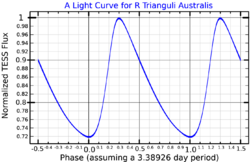Astronomy:R Trianguli Australis
| Observation data Equinox J2000.0]] (ICRS) | |
|---|---|
| Constellation | Triangulum Australe |
| Right ascension | 15h 19m 45.71231s[2] |
| Declination | −66° 29′ 45.7417″[2] |
| Apparent magnitude (V) | 6.73[3] (6.33 - 6.90)[4] |
| Characteristics | |
| Spectral type | F7 Ib/II[5] |
| Variable type | δ Cep[6] |
| Astrometry | |
| Radial velocity (Rv) | −13.2±1.6[7] km/s |
| Proper motion (μ) | RA: −5.113[2] mas/yr Dec.: −8.317[2] mas/yr |
| Parallax (π) | 1.4754 ± 0.0371[2] mas |
| Distance | 2,210 ± 60 ly (680 ± 20 pc) |
| Absolute magnitude (MV) | 2.69[8] |
| Details | |
| Mass | 5.42 or 5.66[9] M☉ |
| Radius | 24.7±1.9[10] or 35.8±0.8[9] R☉ |
| Surface gravity (log g) | 2.10[9] cgs |
| Temperature | 5,852±21[9] K |
| Metallicity [Fe/H] | +0.06±0.08[8] dex |
| Rotational velocity (v sin i) | 16 km/s |
| Other designations | |
| Database references | |
| SIMBAD | data |
R Trianguli Australis is a yellow-white hued variable star in the southern constellation Triangulum Australe. It is near the limit of visibility to the naked eye, having a typical apparent visual magnitude of 6.73.[3] Based upon an annual parallax shift of 1.48 mas,[2] it is located 2,210 light years away. R TrA is moving closer with a heliocentric radial velocity of −13 km/s.[7]
This is a Classical Cepheid variable with an apparent magnitude that ranges from 6.33 to 6.90 over 3.38926 days.[4] It is a bright giant/supergiant with a nominal stellar classification of F7 Ib/II,[5] but pulsates between spectral types F5Ib/II-G5.[4] Depending on the method employed, the estimated mass is 5.42 or 5.66 times the mass of the Sun and it has 24.7 or 35.8 times the Sun's radius.[9] R TrA has an infrared excess that is being emitted by circumstellar silicate dust heated to 150–200 K. It is losing mass at the rate of 4×10−9 M☉·y−1.[9]
References
- ↑ "MAST: Barbara A. Mikulski Archive for Space Telescopes". Space Telescope Science Institute. https://mast.stsci.edu/portal/Mashup/Clients/Mast/Portal.html.
- ↑ Jump up to: 2.0 2.1 2.2 2.3 2.4 2.5 Brown, A. G. A. (August 2018). "Gaia Data Release 2: Summary of the contents and survey properties". Astronomy & Astrophysics 616: A1. doi:10.1051/0004-6361/201833051. Bibcode: 2018A&A...616A...1G.
- ↑ Jump up to: 3.0 3.1 Anderson, E.; Francis, Ch. (2012), "XHIP: An extended hipparcos compilation", Astronomy Letters 38 (5): 331, doi:10.1134/S1063773712050015, Bibcode: 2012AstL...38..331A.
- ↑ Jump up to: 4.0 4.1 4.2 Watson, Christopher (4 January 2010). "R Trianguli Australis". AAVSO Website. American Association of Variable Star Observers. http://www.aavso.org/vsx/index.php?view=detail.top&oid=36665. Retrieved 23 May 2015.
- ↑ Jump up to: 5.0 5.1 Houk, Nancy; Cowley, A. P. (1979). Michigan catalogue of two-dimensional spectral types for the HD stars. 1. Ann Arbor, Michigan: Dept. of Astronomy, University of Michigan. Bibcode: 1978mcts.book.....H.
- ↑ Samus', N. N; Kazarovets, E. V; Durlevich, O. V; Kireeva, N. N; Pastukhova, E. N (2017), "General catalogue of variable stars: Version GCVS 5.1", Astronomy Reports 61 (1): 80, doi:10.1134/S1063772917010085, Bibcode: 2017ARep...61...80S.
- ↑ Jump up to: 7.0 7.1 Gontcharov, G. A. (November 2006), "Pulkovo Compilation of Radial Velocities for 35495 Hipparcos stars in a common system", Astronomy Letters 32 (11): 759–771, doi:10.1134/S1063773706110065, Bibcode: 2006AstL...32..759G.
- ↑ Jump up to: 8.0 8.1 Luck, R. E. et al. (August 2011). "The Distribution of the Elements in the Galactic Disk. II. Azimuthal and Radial Variation in Abundances from Cepheids". The Astronomical Journal 142 (2): 12. doi:10.1088/0004-6256/142/2/51. 51. Bibcode: 2011AJ....142...51L.
- ↑ Jump up to: 9.0 9.1 9.2 9.3 9.4 9.5 Usenko, I. A.; Kniazev, A. Yu.; Berdnikov, L. N.; Kravtsov, V. V. (2014). "Spectroscopic studies of Cepheids in Circinus (AV Cir, BP Cir) and Triangulum Australe (R TrA, S TrA, U TrA, LR TrA)". Astronomy Letters 40 (12): 800. doi:10.1134/S1063773714110061. Bibcode: 2014AstL...40..800U.
- ↑ Moskalik, P.; Gorynya, N. A. (2005). "Mean Angular Diameters and Angular Diameter Amplitudes of Bright Cepheids". Acta Astronomica 55: 247. Bibcode: 2005AcA....55..247M.
- ↑ "R TrA". SIMBAD. Centre de données astronomiques de Strasbourg. http://simbad.u-strasbg.fr/simbad/sim-basic?Ident=R+TrA.
 |


